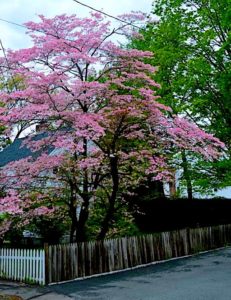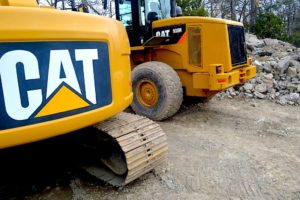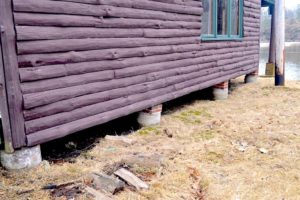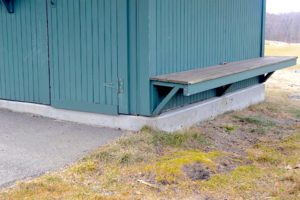By Bruce Wenning
An eco-friendly building foundation system for protecting the mature tree – soil complex on your property from the damaging effects of heavy equipment construction activities.
When my brother, two sisters, and I decided to have a downstairs bathroom constructed on the small family home so our 91-year-old mother could live on the main floor of the house, it was a big decision. We agreed to the project, figured out the contractor, the cost, and the time for completion, but I was worried about damage from heavy equipment to established trees. Construction such as digging in the soil with heavy equipment for a cement foundation creates a tremendous amount of soil compaction, and I knew piling of said soil would cause additional stress to the roots of several large trees in the yard.
How to Save the Big Trees in the Small Yard
The proposed construction portion of the yard supports five World War II-era trees whose roots extend into the proposed construction zone, including four tall trees in the back of the house: eastern hemlock (Tsuga canadensis), sugar maple (Acer saccharum), northern catalpa (Catalpa speciosa), and Norway maple (A. platanoides) (Figure 1). The fifth tree (figure 2), located in the front corner of the yard, is a pink American dogwood (Cornus florida). Again, all five trees’ roots extend into the proposed construction zone of this small property.
- Figure 1: Shows the native sugar maple in fall coloration while the invasive Norway maple still has its summer color in the front yard. October 2008
- Figure 2:This pink dogwood has survived countless attaches from dogwood anthracnose, ice storms, droughts to an occasional bittersweet vine. The first owners planted it around 1945. May 2017
My mother and siblings had no idea how damaging heavy equipment is to soil and associated tree roots. My family, like many contractors and clients, thought that compacted (damaged) soil could be removed and major tree roots cut back after construction was completed. Then tree limbs could be removed, and the entire damaged area could be replaced with new soil, new sod, and new trees. But this work would be an additional expense that was not considered part of the “project” designed to meet our elderly mother’s needs.
By my estimation, the proposed work zone for this small bathroom addition would kill 60% or more of the existing root masses of each tree because the majority of their roots collectively shared the proposed work zone (Figure 3). Figure 3 shows the house and proposed work zone.
Many landscaping professionals agree with university and government plant and soil science researchers that soil compaction is the number one destroyer of trees and tree roots on construction sites using heavy equipment. A situation that is made worse by multiple walking paths and equipment storage places that naturally develop during the onsite construction process (Whitcomb, 1991; Lichter and Lindsey, 1994; Randrup, 1998).
- Figure 3:The center (green) shrub is American holly (Ilex opaca) to its right is a three trunked eastern red cedar (Juniperus virginiana). The previous owners planted both in the late 1940s.
- Figure 4: Heavy soil moving machines commonly used for excavation and moving piles of excavated soil during foundation digging. There are smaller versions of these for smaller sites, but they still cause severe soil compaction.
Figure 4 shows typical excavator machines that may be readily stored on-site during the digging process. They weigh more in tons than the average car causing tremendous soil and tree root damage.
Horticultural Information to the Rescue
When I reviewed the perils of soil compaction and associated plant damage with my siblings and mother, they quickly got the idea. Soil compaction by heavy equipment would cause a decline in these large and cherished trees in time, turning them into eventual hazard trees. These are details from my talking points:
Soil Compaction Characteristics
1.A permanent soil change. According to Randrup (1998), once heavy soil compaction has occurred on a construction site, it can be viewed as a permanent soil structural change. He also states that the normal seasonal freeze-thaw cycles do not undo or reverse the compacted soil to its original native condition.
2.Macropore collapse. The soil pores (voids) that naturally occur in a native soil are a mix of dead organic matter; sand, silt, and clay particles; and all of the living soil organisms (plant and animal) that contribute to what is called the “living soil.” This solid and living complex gets crushed under the weight of heavy equipment. Simply stated, the naturally occurring larger pore spaces or macropores collapse. These pores are the major contributors to water flow and to the oxygen and carbon dioxide diffusion necessary for adequate plant growth. They also allow a multitude of soil life forms to exist (Craul, 1994).
When the macropores are lost, the soil water is retained in smaller or micropores that tend to hold water more tightly. When this happens, there is a greater water flow restriction through the soil profile, both vertically and horizontally (Craul, 1994).
Water moves in the soil through capillary fashion under the natural forces of adhesive and cohesive tension (Whitcomb, 1991). The adhesive property of water attracts other (non-water) surfaces like roots, organic matter, micro-life forms, soil particles, rocks, and the like. The cohesive property of water allows water to be attracted to other water and water mixes like dissolved fertility compounds (Whitcomb, 1991).
3.Micropores take over. Therefore, when compaction reduces and or eliminates the macropores in the soil profile, existing water is forced out of the macropores during soil saturation (i.e. when all soil pores are filled with water). Compaction moves water into the existing and newly created micropores, where it is held very tightly by the adhesive and cohesive properties of water. In addition, soil gas exchange is halted and or significantly reduced. To repeat, when soil is fully saturated, the soil oxygen and carbon dioxide get displaced by water under the forces of soil compaction. As a result, the affected soil remains wet for a more extended time, creating a condition for very limited root growth, water, and nutrient uptake.
4.Plant roots cannot function and grow efficiently and effectively. Compacted soil structure changes the living space for living roots. The macropore component of the native soil, which is so essential for spreading root growth, ceases. Plant roots find it difficult to penetrate this very sudden, oxygen-deprived, new soil particle arrangement. The naturally wandering (exploring) fine root tips can only penetrate soil spaces of the same diameter or larger than their own tiny growing root tips. Once these fine, very small root tips penetrate a void, their size or larger, they can move the soil behind them as they increase in girth (Craul, 1994). However, this root growth behavior is halted under heavily compacted soil conditions.
According to Whitcomb (1991), the abrupt site changes to trees and other plants caused by heavy equipment construction activities eventually cause the unintended targeted plants to starve to death. The energy manufactured via photosynthesis in the leaves becomes depleted, and less energy is transported to the roots. Under continued stress, eventually, the trees’ root reserves become depleted; each tree loses vigor and dies a premature death. The rate of tree decline and death depends on the tree species and on the degree of root damage suffered during construction.
The Small Yard Educated Us to Big Tree Conservation
Given our small lot size, heavy equipment activities did not align with our tree conservation goals. Because of the restricted space, the trees in the yard would be severely impacted by the resulting soil compaction, crushed and cut roots, and heavy equipment activities involving digging and the piling of the excavated soil.
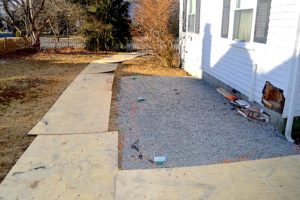
Figure 5: Plywood sheets added to protect the soil, grass, and other plants’ roots from contractors repeatedly walking back and forth from the street to the worksite.
The house lot work area was too small to employ extensive site plant protection techniques. These techniques include installing protective fencing around desirable trees to protect them, using mulch and plywood sheets to help alleviate ongoing soil compaction in the restricted work zone, and reducing foot and small equipment traffic during wet soil events techniques easily employed on larger construction sites (Lichter and Lindsey, 1994). However, the contractor took a proactive stance and put plywood sheets down over the grass to protect the soil from contractor foot traffic (figure 5).
If we had not cared about these mature trees and had more money in the budget, we would have installed the recommended heavy cement foundation and replaced the entire damaged site with new soil and plants. However, this would have changed the look of our mother’s yard from an enchanted, mature tree “mini oasis” to a compacted lot of small replacement trees and turf. In other words, the property would look like it did 75 years ago.
Cement Foundation: Weight-Bearing and Rot Resistant
Boston suburb building contractor, Peter Casten (Mill Cottage, LLC), has been doing home construction and improvements for over 40 years and states that concrete foundations are far heavier than needed to support the typical residential home and home additions. Casten adds that concrete is used because it provides a superior support structure to build upon and can be poured into frames and molded on-site. After it cures or dries, it will not deteriorate underground.
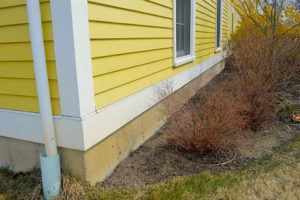
Figure 6: This building has a continuous cement foundation with a cellar. There are no interruptions to the cement foundation; it’s a continuous weight-bearing structure.
Casten also told me that other than a continuous cement foundation (i.e., your typical cellar, see figure 6) or a discontinuous cement foundation (i.e., cement piers, see figure 7) or cement slab (see figure 8), contractors have few to no alternatives for constructing a home or addition on a foundation that will not rot away over time.
- Figure 7: This foundation is a group of cement piers or footings spaced to local building code requirements. This is called a discontinuous foundation.
- Figure 8: This small building has no cellar and is referred to as a slab. The slab is cement and poured into forms for shape. It is below the frost line as determined by the local building code.
The Ecological Approach: Pier foundations, Weight Bearing, Rot Resistant.
As we looked for an ecological solution for our project, building contractor Roger Malcome (Roger A. Malcolm Construction, Natick, MA) saved the day and addressed all our concerns regarding soil compaction and the health of the mature trees in the yard. He suggested we use a little-known pier foundation system called helical piles, and like cement foundations, this foundation will not rot away! Click for a demonstration.
Unlike a dug-out or excavated continuous cement foundation, a pier foundation has proven to be the least damaging to soil and associated living plant roots during and after the installation process (Whitcomb, 1991; Harris, Clark and Matheny, 2004). Different pier systems vary in their diameter, depth, and spacing requirements specified by the local building code. It is worth repeating that pier systems, including their installation process, cause much less soil and plant root damage than dug-out continuous cement foundations, including cement slabs (Harris et al., 2004).
Helical Piles to the Rescue
What are helical piles? The piles or supports are round steel shafts with welded plates (helices) that are mechanically screwed into the ground like a wood screw to form a pier foundation. We used the helical pile system on our project round with protective sleeves (this style is best for weight-bearing home construction) and complies with the local building code. Find additional information at www.premiumtechnical.com.
A Boston area building contractor for 40 years, Roger Malcolm told me that he has used this pier system satisfactorily on certain homeowner projects for about four years. Malcolm suggests that helical piles are best for room additions, decks, and other construction projects in ecologically sensitive areas, or projects that do not warrant the high cost of installing a cement slab or continuous cellar foundation.
According to Malcolm, this little-known pier foundation system requires less time and physical effort than “dig and pour” cement footings and continuous cement foundations. If the specialized pile installation machine reaches the depth of soil needed (below four feet) and correct pounds per square inch (PSI) torque, the helical pile shafts are in line with building code requirements to support a structure. Work can begin immediately as there is no downtime waiting for cement piers or foundations to cure. And there is no destructive digging. See figure 9.
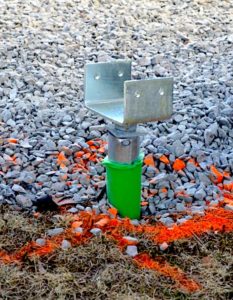
Figure 9: A close-up of the helical piles used on the project. It is a U-shaped support head for the first-floor joist or beam receptivity. The building inspector determines the proper size of the helical pile according to regulations for weight-bearing loads. The helical pile installer determines the appropriate soil depth for the structure being built. The helical pile depth for our project was between seven and nine feet.
After considerable research, my family accepted a Boston area contractor and friend, David Geffen (David Geffen Construction Company, LLC; Waban, MA), to do the work. Geffen welcomed Malcolm’s suggestion of using helical piles as the foundation for the bathroom addition and contracted a certified helical pile installer who installed the piles according to the architect’s design and building code requirements. The installer confirmed that the helical pile system and installation process protected the soil from heavy equipment activity and also pointed out that helical piles are more environmentally friendly and much less expensive than cement foundation construction. Plus the method was “in tune” with my family’s ecological goals.
Geffen pointed out that a continuous cement foundation needs the approval of the local building inspector after its dug and before cement construction begins in order to comply with the building code. On the other hand, helical piles are usually installed within a few hours, and construction can commence immediately.
Geffen also stated that each pile can support the weight of a structure much greater than what is necessary. It’s a true weight-bearing system that served both the construction criteria and ecological concerns presented in our situation.
Figure 10 shows the final bathroom addition. We were all delighted with the entire construction process and pleased that we saved the small yard from heavy equipment destruction while giving our mother a quality downstairs bathroom.
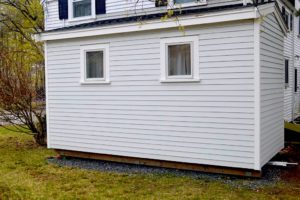
Figure 10: The final bathroom addition supported on helical piles. The entire construction process for this bathroom addition saved the large, WW II era trees from devastating heavy equipment activities. The yard was protected, and the bathroom got built!
In conclusion, there are different helical pile systems on the market, but the ones that pass the building codes for your specific home addition projects are true weight-bearing foundation systems. They can be installed in less than one day without causing significant tree root damage and massive soil compaction to existing trees and shrubs. As a family, we were delighted with this type of weight-bearing foundation.
For a client who is contemplating a room addition or deck with associated cement footings or cellar that threatens the existing mature tree-soil complex, you should investigate helical piles. It is worth looking into this type of pier foundation system to avoid heavy equipment damage and to conserve existing trees and associated native soils on your property. For our family, this proved to be a truly ecological landscaping solution.
To find a helical pile foundation contractor in your state, visit www.helicalpileworld.com.
Literature Cited
Craul, P. J., 1994. Urban Soils: An Overview and Their Future, pp. 115 – 125. In Watson, G. W., and D. Neely (Eds.). The Landscape Below Ground: Proceedings of an International Workshop on Root Development in Urban Soils. International Society of Arboriculture, Champaign, Illinois.
Harris, R. W., J. R. Clark and N. P. Matheny. 2004. Arboriculture: Integrated Management of Landscape Trees, Shrubs, and Vines, 4th ed. Prentice Hall, Upper Saddle River, N.J. 578p.
Lichter, J. M., and P. A. Lindsey. 1994. Soil compaction and site construction: Assessment and case studies, pp. 126- 130. In Watson, G. W., and D. Neely (Eds.). The Landscape Below Ground: Proceedings of an International Workshop on Root Development in Urban Soils. International Society of Arboriculture, Champaign, Illinois.
Randrup, T. B. 1998. Soil Compaction on Construction Sites, pp. 146 – 153. In Neely, D., and G. W. Watson (Eds.). The Landscape Below Ground II: Proceedings of an International Workshop on Root Development in Urban Soils. International Society of Arboriculture, Champaign, Illinois.
About the Author
Bruce Wenning has been on the ELA Board of Directors since 2003. He has university degrees in plant pathology and entomology and is the horticulturist at The Country Club in Brookline, Massachusetts.


